Community News Snippets - January 2014
January 26 - February 1, 2014: Issue 147
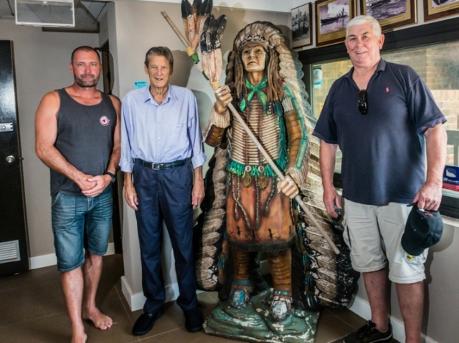
Pontiac Chieftain returns to Warriewood SLSC
PONTIAC (1720 - 1769) - In full ceremonial dress
Pontiac was a chief of the Ottawa Indian tribe. Pontiac was one of the most remarkable men of the Indian race in American history and was notable for his power of organisation.
In 1762 Pontiac was responsible for uniting many of the Indian tribes in what was to become the start of "Pontiac's War" (1763 -1769), a joint Indian campaign to expel the British from their military occupation of the Great Lakes Region.
General Motors established the "Pontiac" trademark and logo in 1926 for the production of a comprehensive range automobiles until 2010. The Pontiac Chieftain vehicles were produced in tje period 1950 -1958.
In 1956 a brand new surfboat bearing the Pontiac Chieftain name and logo was presented to Warriewood Surf Life Saving Club, and in the same year under the expert guidance of Allan Collins, Warriewood won its first Australian Surfboat Championship. The Pontiac logo has been retained by the club ever since and is recognised and respected throughout the world of surf lifesaving......particularly surfboat competition.
Like Pontiac, Warriewood also has strong organising capabilities and determination which will lead them to many future successes.
Insight courtesy of Bob Forbes, who found this Pontiac in the US recently. Bob would like us to pass on thanks to Kennards Hire, supporters of Surf Life Saving, who provided the ute to move Warriewood's mascot at no cost.
Top: Matt Sheridan, president of Warriewood SLSC, Allan Collins, and Bob Forbes. Picture by Michael Mannington.
________________________________________________
BIG SWIM 2014 - Public Gallery HERE
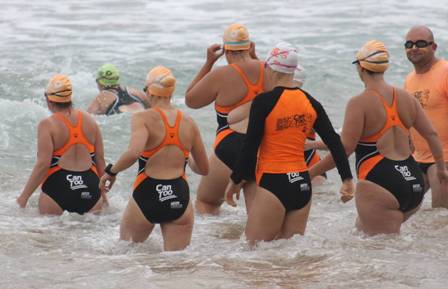
Full report Issue 148 - including a chat with the chaps from Whale Beach who swam in the original swim and the gentleman who won it - Paul Hughes!
____________________________________________
Avalon Beach RSL Presents New IRB Motor to Avalon Beach SLSC
Avalon Beach Surf Life Saving Club were presented with a new IRB motor for the upcoming season on the day of their 22nd Ocean Swim. President Christine Hopton and Avalon SLSC members would like to pass on their thanks to Avalon Beach RSL for their continuing support.
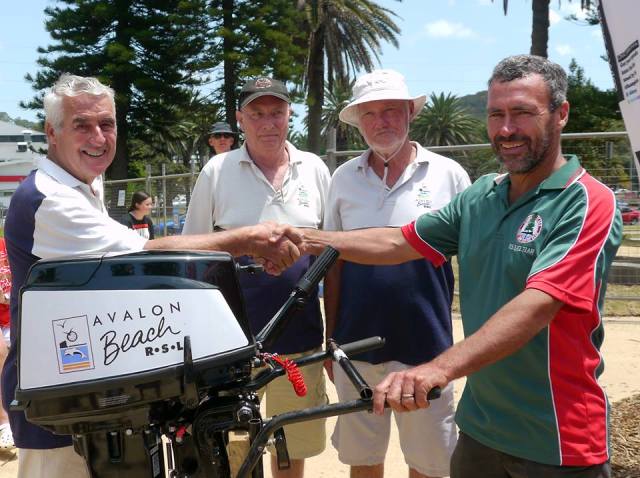
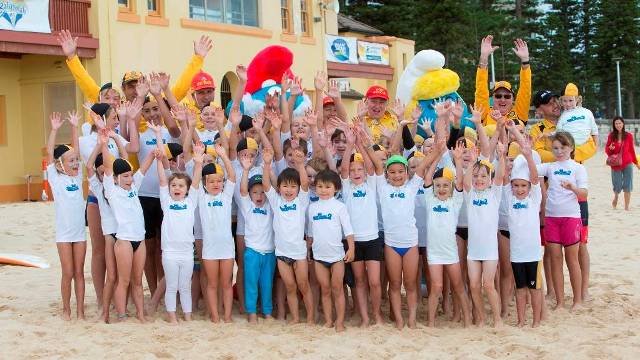
The Smurfs™ Team up with World Champion Surfer Sally Fitzgibbons to Help Keep Kids Safe in the Surf
Surf Life Saving New South Wales has teamed with Universal Sony Pictures Home Entertainment Australia, and Junior World Champion and World Number 3 surfer, Sally Fitzgibbons, to star alongside The Smurfs™ from The Smurfs™ 2 in a national summer surf safety campaign.
Coastal drownings are at an all time high, with 121 fatalities recorded during the 2012/13 financial year. And with 90 per cent of the Australian population living in coastal areas, educating children about the hidden dangers of the surf is more crucial than ever.
Sally Fitzgibbons has called on her true blue friends, The Smurfs™, to deliver some easy-to-understand tips that Aussie kids can follow to ensure they keep safe when at the beach over summer. An educational video targeted at children, starring Sally Fitzgibbons and The Smurfs™ demonstrating the five surf safety tips can be viewed on Surf Life Saving New South Wales' website at:www.surflifesaving.com.au/about/beach-safety
Sally Fitzgibbons said, “Families flock to the beach over the summer holidays to cool off and have some fun together. In a country that’s shaped by beach culture, it’s important to teach kids about the dangers to look out for to ensure they still have fun, but also stay safe in and around the water.
"Teaming up with The Smurfs and Surf Life Saving means we’re hitting kids with the safety message directly, and using characters they know and love, to help deliver five key surf safety tips they can easily put in to practice this summer."
Andy Kent from Surf Life Saving NSW said, "Summer holidays are a great opportunity for families to relax and unwind, but it is also the busiest time of year for us. To partner with Sally Fitzgibbons and Universal Sony Pictures Home Entertainment during our peak season to help deliver these key surf safety tips will go a long way towards ensuring families can safely enjoy the beach while also reducing the risk of coastal drownings in the future."
_________________
We’re currently running the key Safety Messages in our Children’s page, and some wonderful pictures from the Summer Safety Event held at North Steyne SLSC on the 9th of January. If we all take a bit of time to reiterate these to our younger beach goers we may turn the tide on these tragic events.
The five key surf safety messages:
* Always swim between the flags
* Always ask a lifesaver for advice
* Read the safety signs
* Always swim with a friend
* If you need help, stay calm and attract attention
There’s also a great video featuring Sally on our Children’s page to look at after your children have seen the Smurf’s and children’s pictures.
January 19 - 25, 2014: Issue 146
220 marine scientists raise alarm about NSW recreational fishing - 14 January 2014
More than 220 marine scientists from across Australia and internationally, including from the University of Sydney, have raised concerns for NSW's marine life if the state government moves to permanently allow recreational fishing in no-take sanctuary zones.
In advance of the imminent and globally unprecedented decision, 222 marine scientists have written a joint statement to the NSW premier, Barry O'Farrell, urging him to keep no-take marine sanctuary zones free from fishing, in keeping with well-established scientific practice.
Dr Will Figueira, a marine ecologist at the University of Sydney's School of Biological Sciences and president of the NSW branch of the Australian Marine Sciences Association, said:
"Last year Premier O'Farrell temporarily allowed recreational fishing in sanctuary zones, a decision made without consultation and not based on scientific research."
"Now the government may decide to make fishing in sanctuary zones a permanent feature of marine parks in this state.
"The concern felt by the science community, both in NSW and internationally, is of such significance that an unprecedented number of scientists have been motivated to write to the premier.
"Permanently allowing fishing in protected no-take sanctuaries will undermine their conservation value. No-take zones are essential for maintaining healthy marine life over the long term and serve as buffers against the risk of over-fishing.
"Around the world, scientists support marine sanctuaries as an essential tool for protecting marine life. However for these zones to be effective there must be no take of any kind."
NSW has six multiple-use marine parks, each with no-take marine sanctuary areas zoned within them.
Sanctuaries account for only seven per cent of NSW state waters, which extend three nautical miles (5.5 km) from shore. It is these state waters where both extraction of resources and biodiversity values are most intense.
Marine ecologist Professor David Booth, from the University of Technology, Sydney, said:
"Globally, the scientific evidence is overwhelming that no-take sanctuary zones are essential to protect our marine life, and NSW is unique in the developed world in allowing fishing back in."
"A decision to allow any form of extractive use in NSW marine no-take zones would represent a fundamental backwards step in our efforts to protect our diverse coastal ecosystems from the impact of ever-growing human pressures. "
The joint statement has been supported by fourteen academics and researchers from the University of Sydney.
Science statement on marine park zoning in New South Wales - 13 January 2014
We the undersigned marine scientists are concerned that the integrity of the NSW marine parks network and marine conservation objectives will be severely undermined by Government moves to allow recreational fishing in sanctuary zones.
From the cool waters in the south to the warm waters of the north, the coral reefs, estuaries, seagrass meadows, sandy beaches, rocky headlands, kelp beds, sponge gardens, subtidal and deep-water rocky reefs, sandy plains and seamounts in NSW support a rich mix of tropical and temperate marine life. This includes marine turtles, tropical fish and manta rays in the north, blue devilfish, weedy seadragons, fur seals and sharks down south, and humpback whales seasonally migrating along the 2000-kilometre NSW coast.
The NSW marine parks network began its protection of marine life in 1991 with the establishment of the Solitary Islands Marine Park. Since then five other marine parks have been created, each after extensive scientific research and community consultation, and each linking with the Commonwealth marine bioregional plans. The knowledge
and expertise of the NSW marine science community has been critical to building the network. In response to the feedback received during the zoning process, the current network (before the government’s action) allowed for all forms of recreational fishing in about 93% of the NSW coastal environment (>10,000km2). It also set aside about 1,800km2 of the coast (~17%) as “Habitat Protection Zones” which allow nearly all forms of recreational fishing but only a very limited set of commercial activities.
In contrast to these transparent and well-informed zoning processes, the NSW Government decision in March 2013 to temporarily allow recreational fishing in sanctuary zones off beaches and headlands was not based on any scientific research or consultation, and failed to establish the necessary scientific protocols for the monitoring
of impacts on marine life that would result. It is now of significant concern to the marine science community that what was announced as a temporary lifting of restrictions on recreational fishing in sanctuary zones may become a permanent feature of marine parks management in this state. Such a move would represent a considerable step
backwards in environmental awareness in the country’s most populous state and as such has drawn the attention of inter-state and international marine scientists.
Sanctuary zones free of extractive activities, such as recreational fishing i.e. ‘no-take’, must be the corner stone of marine conservation. Their prime purpose is the conservation of marine life and ecological processes, but there is increasing evidence from Australia and overseas that sanctuary zones can help reverse the decline in marine health, build the resilience of marine life to climate change, and serve as buffers against overharvest which often occurs under conventional fisheries management.
The habitats in sanctuary zones off sandy beaches and rocky shores, where restrictions on recreational fishing have been temporarily lifted, are vital for many fish communities. These areas are also likely to be the most heavily exploited due to ease of access by fishers. The most recent data indicates that recreational fishers take a quarter or more of the catch in 11 of the state’s top 20 harvested species including those commonly found in
beach/headland habitats such as whiting, flathead, bream, luderick, tailor, snapper, kingfish and leatherjackets.
To suggest, as the government is doing, that risk and threat assessment in combination with fisheries management are sufficient for marine conservation, fails to understand the fundamental difference between the management of resource exploitation and the conservation of biodiversity. The latter seeks to preserve habitats and species in a natural state while the former seeks to optimize harvest. Thus even when done perfectly,
management of resource extraction cannot deliver the marine conservation benefits that a network of marine parks with sanctuary zones can provide.
The signatories to this statement urge the NSW Government to reinstate the protection levels for sanctuary zones by no longer allowing recreational fishing of any form within them, and to work with the marine science community to establish a scientific research program that targets knowledge gaps and supports evidence-based decisions about marine conservation planning.
The 222 signatories to this Statement dated 13 January 2014 follow in alphabetical order:
Retrieved from: HERE
_________________________________________
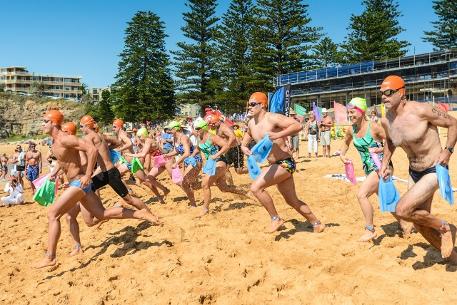
Avalon Ocean Swim 2014
The 22nd Avalon Beach SLSC Ocean Swim took place last Sunday, 12th of January with 450 finishers. All results here
Michael Mannington and Mike O'Flynn went along and took some great pictures which are available free to download HERE.
The Warriewood to Mona Vale swim is on this morning (19.1.2014) and the 40th running of THE BIG SWIM will take place next Sunday - 26th of January - Australia Day - see details on this week's Front Page.
_____________________________________________________
We're Losing Our Wallabies
Northern Beaches Roadkill Prevention states that another couple of swamp wallabies were recently killed on Wakehurst Parkway near the junction with Warringah Road;
“these are the fauna most affected by the proposed hospital site at Frenchs Forest. We will see more and more animals lose their habitat and be killed on that incredibly busy road. See Change.org for our petition to stop the building of the hospital on that site.”
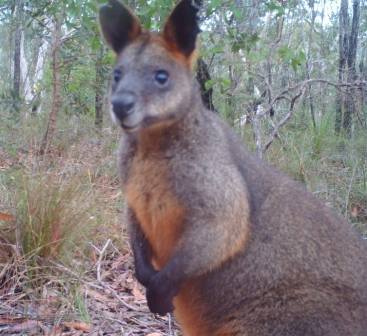
A swamp wallaby in the bush on Northern Beaches – pic c/ - NBR
____________________________________________
LOCAL GOVERNMENT PANEL, TASKFORCE FINAL REPORTS RELEASED - Wednesday 8 January 2014 - NSW GOVT. MEDIA RELEASE
Minister for Local Government Don Page today said the final reports of the Independent Local Government Review Panel and the Local Government Acts Taskforce had been released.
Mr Page thanked both the Panel and the Taskforce for their thorough consideration of the issues facing local councils and their communities. “We made an election commitment of no forced amalgamations of councils and that commitment continues as we discuss the options proposed by the Panel,” Mr Page said.
“Some ideas in the reports will require careful consideration and development. We need to take the time to get this right. The reports show quite clearly that local government is facing many challenges and that “no change” is simply not an option if we want NSW to become No 1 again.
“However, this change needs to be developed in partnership with councils and their communities.’’
Mr Page said releasing both final reports for a period of comment until 7 March 2014 would help the NSW Government develop its response and give a final opportunity for councils and their communities to provide input on the way forward.
“We need to work together to identify what is really important and what needs to be done to strengthen and support the system of local government,’’ Mr Page said.
“The NSW Government is committed to helping councils and their communities have a strong local government sector and to find solutions that work.’’
Mr Page said there had been a great deal of discussion, research and reviews to lead to the point of releasing the reports.
“The Local Government and Shires Associations (now Local Government NSW), recognised the need for change and requested this review by the Independent Local Government Review Panel.’’
Both the Panel and the Taskforce had spent the past year considering the issues in detail and consulting with councils and their communities.
“The Government wants to get on with reform and prepare a response to these two important reports. In preparing this response there will now be an opportunity for communities and their councils to comment.’’
The reports are available on the Division of Local Government’s website at www.dlg.nsw.gov.au
_______________________________________________________
Public comment sought on Energy Policy Issues Paper
Minister for Industry Ian Macfarlane has released an Issues Paper to begin consultation on the Australian Government’s Energy White Paper.
“This is an important step in the process of completing the Government’s Energy White Paper process,” Mr Macfarlane said.
“The Issues Paper is centred around reducing cost pressures on households and businesses, and will include matters such as security of energy supplies, regulatory reform and energy productivity.
“The Issues Paper also seeks comment on growth and investment to maintain Australia’s competitive position, trade and international relations, workforce productivity to meet ongoing industry demand and alternate sources of energy to diversify our energy mix.”
Industry and community input will inform possible policy approaches for a Green Paper, which will be released for consultation in May next year. Input on the Green Paper will then inform the final Energy White Paper, to be released later in 2014.
“The Energy White Paper will set out a coherent and integrated approach to energy policy to boost domestic market competition and productivity, maintain international competitiveness and grow our export base.”
Mr Macfarlane said the Government’s Energy White Paper will deliver stable energy policy and efficient and transparent markets that promote user choice and put downward pressure on energy costs.
The Energy White Paper will be produced in conjunction with other Government reviews including the development of the Eastern Australian Gas Supply Strategy to 2020.
Submissions on the Issues Paper must be made by 7 February 2014. The Issues Paper and details on the submission process are available at www.ewp.industry.gov.au.
________________________________________________

COMMUNITY CONSULTATION WIDENS ON INGLESIDE
A new website – www.inglesideplanning.com.au - has been launched to involve the Pittwater community in future planning for Ingleside, ahead of several community workshops planned in early 2014. Pittwater Mayor Jacqui Townsend said planning was underway and the community was invited to help develop a vision for Ingleside by contributing ideas and comments.
“We’re aiming for a sustainable community in Ingleside that has a triple-bottom-line approach to development, addressing environmental, social and economic aspects.”
The website contains a live discussion forum, invites votes on ideas and also lets residents ‘pin’ their comments on a map of the area.
The NSW Department of Planning & Infrastructure, UrbanGrowth NSW and the Council are conducting a ‘precinct planning’ process for Ingleside which is expected to take around 18 months.
Precinct planning takes a holistic approach to a land release, taking into account factors such as the local environment, community consultation, infrastructure requirements, housing needs and economic viability.
Mayor Townsend said the website was interactive to encourage the community to have their say on Ingleside’s future.
“Early next year, we will move into more consultation with the community to further develop the vision for Ingleside.”
“This will be done through ‘enquiry by design’ workshops, which will help the public voice their ideas under the guidance of architects and town planners.”
More information on the workshops will be made available early next year.
Mayor Townsend said the Council had formed an Ingleside Community Reference Group composed of 15 residents, landowners and business-owners, Councillors and planning staff.
The reference group is intended to give community input to the precinct planning process and also distribute information about the process to local networks.
“The group is meeting regularly and is particularly interested in seeing sustainable development as the hallmark of any future land release,” the Mayor said.
January 12 - 18, 2014: Issue 145
And while you're all on holidays....
LGNSW demands the NSW Government extend time for councils to respond to Review Panel Report – 8th of January, 2014 - Media Release
Local Government NSW (LGNSW) today slammed the NSW Government for imposing such a limiting consultation deadline for councils to respond to the Independent Local Government Review Panel’s final report which was released today.LGNSW is calling on the NSW Premier, the Hon. Barry O’Farrell MP, to extend the consultation period until the end of April 2014.
Direct link to report HERE (PDF - 124kb)
President of LGNSW, Cr Keith Rhoades AFSM, said the vast majority of NSW councils do not have their first council meeting for 2014 until February, leaving little to no time for them to properly consider and respond to the NSW Government’s 7 March consultation deadline.
“The Minister’s had the Review Panel’s report for nearly three months; we’ve had it for three minutes!” stated Cr Rhoades.
“If the NSW Government is serious about working with councils to improve the capacity and financial sustainability of Local Government, they need to live up to their end of the Intergovernmental Agreement.”
“There is no document more important for Local Government in NSW than this one, the Premier and Minister Page must provide a consultation timeframe that is suitable for councils and the communities they represent – not an arbitrary date picked by Cabinet.”
“The Report is extremely detailed and complex and there are significant changes in the Review Panel’s recommendations since the last discussion paper, we at Local Government NSW need time to consider the changes and the impact on the sector. Councils also need time to study it and consult with their communities on the numerous changes that have been suggested.”
“Local Government NSW plans to canvass council views in early/mid-March, once Mayors and Councillors have had a chance to discuss the report. We will be holding a series of forums in regional and rural locations as well as the Sydney metropolitan area to listen to our members.”
“Obviously, Local Government’s main concern is council amalgamations. While the report does not support forcibly amalgamating councils, it does provide a very detailed ‘merger’ blueprint for a future state government without the current ‘no forced amalgamations’ policy.”
“The other key issue we believe our member councils will want to discuss are the new structures proposed for Local Government, particularly in rural and regional areas. These include what the Review Panel refers to as Joint Organisations, Rural Councils and Community Boards.”
“These new structures coupled with suggested amalgamations provide complicated solutions to the problems faced in rural NSW, and will need to be examined in great detail.”
“With that said, many councils in NSW face a funding crisis for which there is no easy answer under the present system. We recognise changes need to be made. Aspirational communities demand more and better services, and there is always a reluctance to pay the true cost.”
“There is often a great divide between city and country councils, and we cannot let those who live outside the big cities become second-class citizens through lack of funding, the inability to recruit skilled staff (in some areas), and access to the latest technology.”
“We are no longer simply in the business of rates, roads, and rubbish; we need a Local Government system that is equipped to cope with current and future pressures. This will not be achieved by imposing unfair consultation deadlines on the very sector we are trying to improve.”
LOCAL GOVERNMENT PANEL, TASKFORCE FINAL REPORTS RELEASED - Wednesday 8 January 2014 - NSW GOVT. MEDIA RELEASE
Minister for Local Government Don Page today said the final reports of the Independent Local Government Review Panel and the Local Government Acts Taskforce had been released.
Mr Page thanked both the Panel and the Taskforce for their thorough consideration of the issues facing local councils and their communities. “We made an election commitment of no forced amalgamations of councils and that commitment continues as we discuss the options proposed by the Panel,” Mr Page said.
“Some ideas in the reports will require careful consideration and development. We need to take the time to get this right. The reports show quite clearly that local government is facing many challenges and that “no change” is simply not an option if we want NSW to become No 1 again.
“However, this change needs to be developed in partnership with councils and their communities.’’
Mr Page said releasing both final reports for a period of comment until 7 March 2014 would help the NSW Government develop its response and give a final opportunity for councils and their communities to provide input on the way forward.
“We need to work together to identify what is really important and what needs to be done to strengthen and support the system of local government,’’ Mr Page said.
“The NSW Government is committed to helping councils and their communities have a strong local government sector and to find solutions that work.’’
Mr Page said there had been a great deal of discussion, research and reviews to lead to the point of releasing the reports.
“The Local Government and Shires Associations (now Local Government NSW), recognised the need for change and requested this review by the Independent Local Government Review Panel.’’
Both the Panel and the Taskforce had spent the past year considering the issues in detail and consulting with councils and their communities.
“The Government wants to get on with reform and prepare a response to these two important reports. In preparing this response there will now be an opportunity for communities and their councils to comment.’’
The reports are available on the Division of Local Government’s website at www.dlg.nsw.gov.au
__________________________________________________________________________
Blueprint To Help Cut Drownings In Bega Valley – Surf Life Saving NSW - News
A state-wide coastal public safety risk assessment project begins next week in the Bega Valley Local Government Area (LGA) with the aim of reducing coastal drownings across NSW.
Surf Life Saving NSW’s Project Blueprint aims to help reduce coastal drowning deaths by assessing every beach and rock platform in NSW over the next few years. The second year of the project will see the coastlines of five local government areas assessed including Bega Valley.
Through the NSW Water Safety Black Spot Fund, Surf Life Saving NSW is using the expertise of Australian Coastsafe, a wholly-owned business unit of Surf Life Saving Australia, to complete the project.
From 16th January to 19th February, Surf Life Saving NSW Coastal Risk Officers will assess over 180km of coastline covering 156 locations including 102 beaches and 54 rock platforms throughout the Bega Valley Shire Council and National Parks in the Bega Valley LGA.
SLSNSW Coastal Risk Manager Adam Weir, says while the scope of the project is daunting, the information is vital to providing water safety agencies with an effective strategy to reduce the coastal drowning toll.
“Each year, many lives are lost along our coastline, leaving families devastated and communities in shock. Our goal is to reduce drowning deaths by 50 percent within the next decade,” explained Mr Weir.
More than 350 people have drowned in NSW since 2004 – 11 of them along the coastline of the Bega Valley. The vast majority are people caught in rip currents while swimming, or swept from rocks while fishing and almost all occur at unpatrolled locations or outside patrol hours.
Bega Valley Shire Mayor, Bill Taylor said the project will be extremely valuable to rescue agencies and ocean goers alike.
“Many people get into trouble in the surf because they misunderstand or underestimate the conditions. Having our coastline assessed by Australian Coastsafe will result in a broader understanding of the threats and conditions unique to every beach in the shire.
“We’ve had near misses and tragic losses in recent months, so it is very welcome news to hear of this valuable risk assessment project. We will be offering our full support to Australian Coastlife as the project unfolds.” he said.
Tim Shepherd, Manager for the Far South Coast Region of the National Parks and Wildlife Service said, “The National Parks and Wildlife Service are looking forward to working with staff from Surf Life Saving NSW to review and improve safety on local beaches”.
“It is good to see state and local government working together in a co-operative manner sharing expertise,” said Mr Shepherd.
Over four years the project will aim to cover 1,590 km of coastline, which includes 600km (38%) of rocky coastline and 990km of sandy coastline (62%). An estimated total of 892 locations will be assessed as part of the project.
Areas already targeted in the first year and a half of 'Blueprint' include Tweed, Byron and Ballina areas, Coffs Harbour, Lake Munmorah, Wyong, Randwick, Wollongong, Coffs Harbour, Gosford, Waverley and Sydney’s Northern Beaches (Pittwater, Warringah and Manly).
The assessment process examines a range of factors which can impact on risk, including education and information, signage and beach access, lifesaving and lifeguard services and the skills of those taking to the water. Local surf clubs and communities will be consulted throughout the project.
Final assessment reports will be provided to the NSW Government and other relevant agencies and land managers, creating a working ‘Blueprint’ for a state-wide coastal drowning prevention strategy.
For more information on Project Blueprint and to find out how to be part of the consultation process, visit www.coastsafe.org.au/blueprint.
_____________________________________________________________________
Warning on Hoax E-waste Kerbside Collection Notices
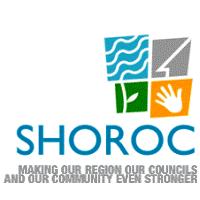 The SHOROC partner councils (Manly, Mosman, Pittwater and Warringah) are advising Northern Beaches residents to be wary of hoax letterbox notices attempting to trick households into placing their unwanted electrical equipment on the kerb for a collection that never occurs.
The SHOROC partner councils (Manly, Mosman, Pittwater and Warringah) are advising Northern Beaches residents to be wary of hoax letterbox notices attempting to trick households into placing their unwanted electrical equipment on the kerb for a collection that never occurs.
Thousands of households in Mosman recently received fake flyers asking residents to place televisions, computers and other electrical appliances on their kerb for collection.
The organisers of this bogus collection then cherrypicked valuable items and cut off electrical cords for the copper and left the rest which residents then had to clean up themselves.
SHOROC President and Mayor Pittwater Jacqueline Townsend noted that the timing of this activity around the analog television signal switch-off in Sydney on 3 December and the upcoming end-of-year sales may encourage unscrupulous people to conduct similar scams over the holiday period.
“Our SHOROC councils recently flagged television disposal options to their communities following the analog switch-off noting that they should not put televisions in bins and never leave them on the kerb.
“Residents can keep their old televisions and purchase a digital set-top box, swap their old televisions when purchasing new ones at participating retailers or recycle their televisions for free at Kimbriki and Belrose resource recovery centres or other approved drop-off points that can be found at recyclingnearyou.com.au,” Cr Townsend said.
_____________________________________________________
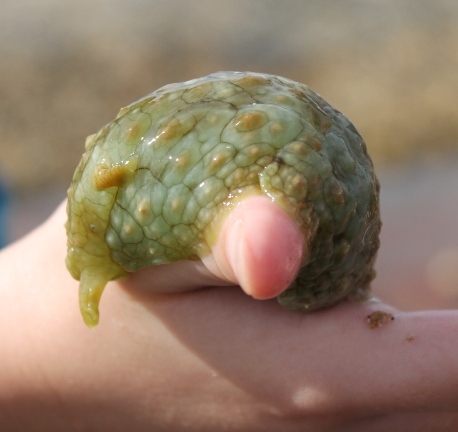
THAT’S JUST WRONG
C/ - Northern Beaches LAC - NSW Police Force
Yesterday (3.1.2014) a local beach goer was horrified to see 8 people filling buckets with starfish, sea slugs and sea urchins from rock pools at North Curl Curl beach. The horrified local heard these people saying it was “for their fish tanks”.
This behaviour is strictly prohibited and much of the Northern Beaches seashore is an ‘Intertidal Protected Area’.
If you see anyone taking sea creatures from our beautiful beaches, please contact the police, council rangers or NSW Fisheries.
Offences carry on the spot fines of up to $500.
Marine Protected Areas include Intertidal protected areas (IPAs) (see below); Aquatic reserves such as Shelley Beach/Cabbage Tree Bay and NSW Marine Parks.
Intertidal protected areas (IPAs) have been established to protect selected rocky habitats and intertidal species. They aim to:
• protect intertidal community biodiversity and structure;
• provide biological reservoirs of breeding stock so exploited areas nearby can be recolonised or sustained; and
• help ensure harvesting of intertidal invertebrates is undertaken at sustainable levels.
What you cannot do in an IPA
All IPAs extend from the mean high water mark to 10 metres seaward from the mean low water mark. Collecting seashore animals is strictly prohibited in these closures. This includes crabs, snails, cunjevoi, octopus, sea urchins, anemones, pipis, cockles, mussels, oysters, and nippers (saltwater yabbies). See Protecting Seashore Animals for further information.
What you can do in an IPA
Fishing is permitted in these areas, but bait collection is not allowed, although you may bring bait with you up to the quantity allowed by recreational fishing bag limits.
Background
In 1993, 14 intertidal protected areas were established around Sydney as a component of an integrated management approach to minimise threats and ensure the sustainability of rocky shore animals and plants. At the same time new bag limits were introduced and methods of collection were restricted and defined.
Following community consultation, six of these sites were permanently protected as Aquatic reserves (www.decc.nsw.gov.au) on March 31, 2002. These were: Barrenjoey Head, Narrabeen Head, Cabbage Tree Bay (a section of the former Shelly Beach Headland IPA), Bronte-Coogee, Cape Banks and Boat Harbour. These sites are now managed by the Department of Environment and Climate Change (www.dec.nsw.gov.au).
The intertidal protected areas are located at: Bungan; Mona Vale; Dee Why Head; Shelley Beach
For more on our sealife on coastal platforms see HERE
Above: Sea Hare (Hairy Sea Slug) by AJG Feb, 2013.
January 5 - 11, 2014: Issue 144
Sassy takes out the coveted Island Trophy – C/ - Pittwater Offshore Newsletter
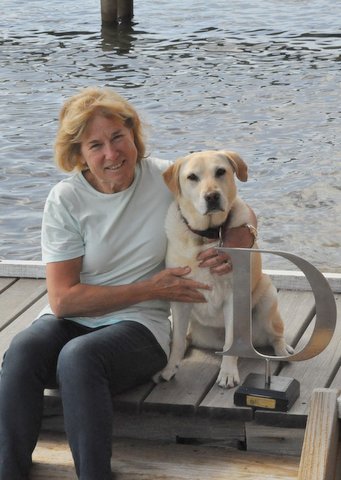
Sassy and Ruth
Sassy Gaines, winner of the 2013 Scotland Island Dog Race. Sassy is a 5-year veteran of the race and her race strategy finally paid off this year. She is a 7 year old rescue labrador retriever who LOVES to swim.
Images by June Lahm
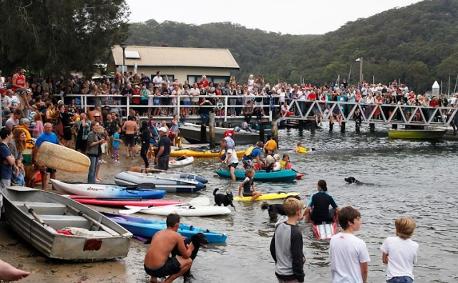
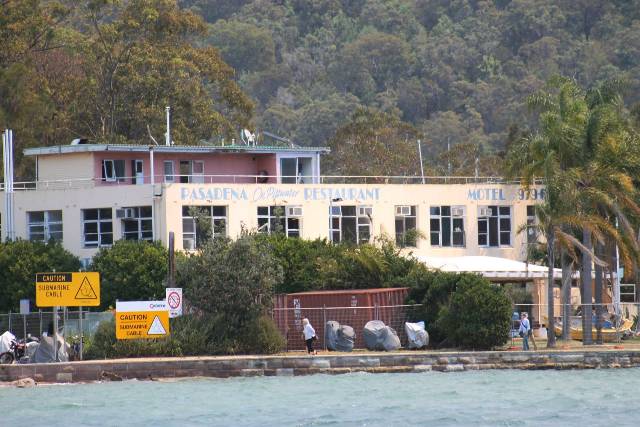
PASADENA UPDATE – DA REFUSED, APPEAL DISMISSED - c/- Pittwater Offshore Newsletter
On December 24, the Land and Environment Court handed down its decision on the Pasadena DA.
Court Decision:
1.The appeal is dismissed.
2.Development Application No. N0021/13 for alterations and additions to an existing building for continued use as a restaurant, cafe, motel and retail shop is refused.
3.The exhibits, other than exhibits 10, A and D, are returned.
Here is a link to the full case document: LINK (PDF - 1.7 MB)
Keep your eyes peeled for any future information as it comes to hand!!
Above: Pasadena at Church Point - Pic. by AJG
_______________________________________________________
Southern Cross Wildlife Care - Critter of the Month - January 2014 - curated by Lynleigh Greig
Cecil's Story
Cecil the Diamond Python was rushed to us at 10pm on a Friday night in October of last year by Sonja Elwood, one of Sydney Wildlife’s finest volunteers.
He was halfway to heaven...
With severe stomatitis of the mouth, multiple inexplicable body wounds, a crushed tail and pneumonia, we thought he wouldn’t make it...!
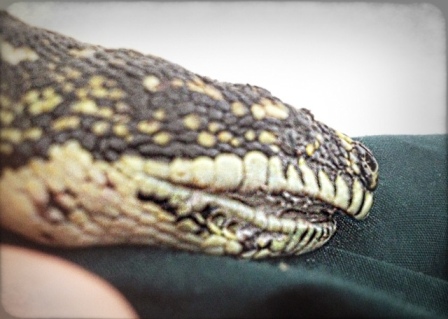
Dr Ralph started working on him immediately to clear away the pus from his mouth and tongue (which was completely cut off by exudate). He had to extract pus from all the way down his respiratory tract. One of his eyes was also severely shrunken and shrivelled. We weren’t sure it could be saved.
After an hour of intense treatment, Cecil was sent home with his carer. His prognosis for recovery was somewhat guarded...
After a week of antibiotic injections, daily administrations of sub-cutaneous fluids and daily gum-scraping, Cecil was starting to look more human... Well, reptilian...!
Even his shrunken eye was showing promise.
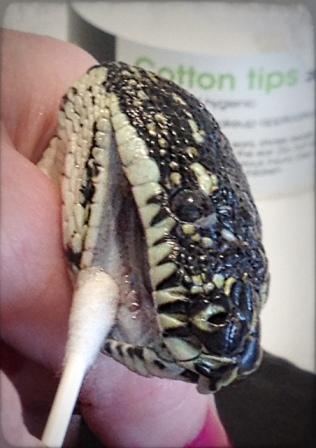
He was always very sweet and patient throughout his treatments and only huffed and puffed every now and again to express his humiliation.
Once he started to feel better, we had to address his tail issue. When he’d presented with a crushed tail, we’d hoped the antibiotics might help, but things didn’t improve so the decision was made to amputate the end of his tail to prevent it getting in his way.
He was anaesthetised, the procedure undertaken and the wound sutured.
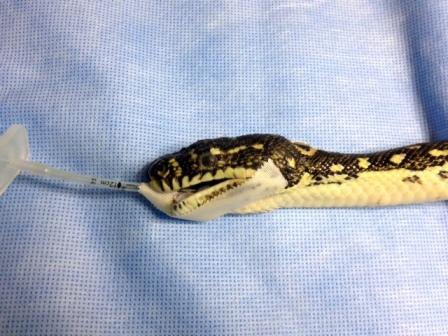
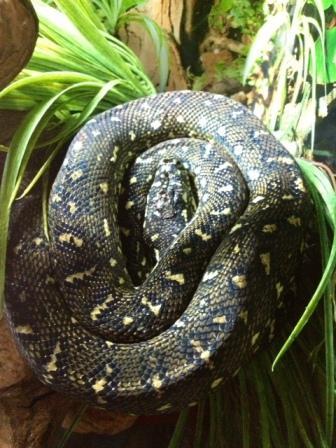
He was taken home by his carer and put to bed.
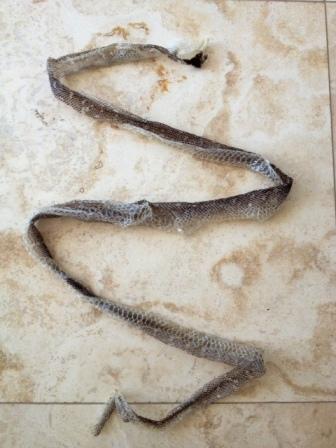
Cecil’s first skin-shed caused much excitement! A good shed is a sign of a healthy snake. This is his beautiful skin which we will keep as a souvenir and to remind us of this gentle soul who placed his safety and life into our hands.
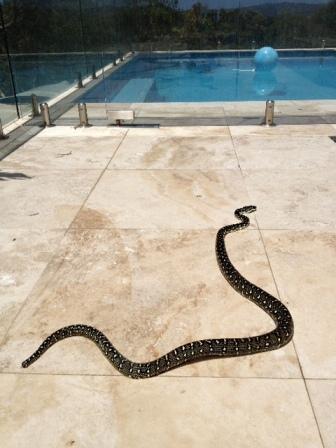
Here is our beautiful boy catching some sun beside his carer’s pool. You can see how well his tail healed.
His recuperation period so far has been 9 weeks.
Would you believe this is the same animal? What a handsome boy!
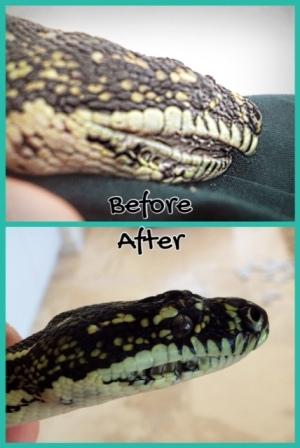
Cecil is having his sutures removed on Thursday and then he is free to go. As we don’t know where he originated from, he will have to be released in a place where we know he will be safe.
A wonderful member of the public in Avalon has offered him a home in his glorious backyard where there is ample space for him, many native trees for him to climb and lots of sunny spots for basking.
Good luck, Cecil, you are a wonderful boy but please stay out of trouble, young man...!
Thank you to the member of the public who found him in his hour of need, thank you to Sonja Elwood for rushing him over on a Friday night and thank you to Nick who will be keeping a watchful eye on him in his new home...
_____________________________________________

From 6 January 2014, Pittwater's general clean-up waste collection will be a pre-booked service. Items will be picked up on the same day of the week as your garbage and recycling. Bookings are being taken from Monday 16 December and collections will begin from 6 January. Phone 9970 1233 to book; more info here
NEWPORT TO GET WHARF UPGRADE
The wharf at Queen Street Newport will receive an upgrade through Council’s major works program during January, with work expected to be completed by early February. The wharf will be closed for approximately one month while work is carried out on the upgrade, during which time commuter vessels will need to use other public wharves such as Rowland Reserve, Bayview and Church Point Wharf.
Council’s Reserves and Recreation Manager Les Munn said the upgrade would entail removing the old wharf and then construction of a new wharf and steps in its place.
“The upgrade has been planned during January so work can be completed before school resumes in February,” he said. “There are a large number of school students who commute from our western foreshores, so we will work to have the upgrade completed by 2 February.”
Mr Munn said that if wet weather held up construction the Council would provide a shuttle bus for the students.
“If needed the shuttle will take children to Newport Public School directly from Church Point wharf in the mornings and return them there from school in the afternoon.”
In addition to the work being carried out by the Council, Rowell Marine will also be installing a pontoon and ramp to the new wharf as a community benefit project.
“This initiative will provide additional access for recreational boats,” added Mr Munn.
For further information about Council’s planned upgrade to Newport Wharf visit www.pittwater.nsw.gov.au/council/major_projects
ARTZPACE ARTISTS AT AVALON
Eleven artists’ work will be featured in the Council-sponsored ArtZpace exhibition between 4 and 12 January 2014 at Avalon Recreation Centre. ArtZpace is an initiative of Council to stimulate interest in emerging artists and to provide exhibition space to show their work.
The group has been working on the exhibition since July this year and involved in all aspects of its planning.
Participant Elizabeth Cashmore explains; ‘each member contributes their own individual strengths to running the show, while developing networks and friendships with local artists’.
The biennial ArtZpace exhibition is a feature of Pittwater’s arts calendar, with thousands of visitors attracted to the variety and quality of work on exhibition.
Mayor Jacqui Townsend said ArtZpace was a ‘fantastic opportunity for the community to see fresh work by emerging artists from across the northern beaches.’
“Many of the artists are influenced by life on the northern beaches, featuring the beach, waterways and native wildlife in their work.”
The artists participating in ArtZpace 2014 have also included a silent auction to raise funds for Bear Cottage as part of the program. The 2014 ArtZpace artists are Nicole Ballingal-Price, Lorraine Beal, Michael Biddulph, Elizabeth Cashmore, Murray Coddington, Jacqui Giuliano, Tina Hunter, Candy Le Guay, Richard Magee, Jane Rich and Fiona Verity.
The ArtZpace opening night takes place on Friday 3 January 2014 from 6pm to 9pm at the Avalon Recreation Centre, 59a Old Barrenjoey Road Avalon.
ArtZpace runs from Saturday 4 to Sunday 12 January 2014 from 10am to 5pm. For information visitwww.pittwater.nsw.gov.au/artzpace
FUN SUMMER HOLIDAY ACTIVITIES FOR KIDS
Pittwater Council’s Coastal Environment Centre (CEC) has announced the release of its exciting summer holiday program for kids. Kids on the Coast offers healthy and fun outdoor activities for 5 to 12 year olds from Monday 6 January to Friday 17 January 2014.
There will be a mix of activities including Rock Platform Investigators where kids can learn about the amazing creatures that call rock platforms home. Alternatively they can meet some scaly friends, learning about these fascinating creatures in Reptile Romp. Or check out our amazing native animals in Wildlife Wonders.
Two art workshops will be also offered by a professional artist helping kids create some fantastic artworks inspired by the coast.
Natural Environment & Education Manager Mark Beharrell said the program encouraged children to explore beaches, rock platforms, headlands, bushland, wetlands and the Narrabeen Lagoon foreshore.
“Kids on the Coast is the ideal school holiday experience. The program gives children the chance to learn about our natural environment in a fun and interactive way,” said Mr Beharrell.
Most session times are from 10am to 3pm. The cost is $55 per child, (for standard activities) which includes supervision between sessions (BYO lunch).
The Kids on the Coast program was awarded top prize in the 2011 Northern Beaches Local Business Awards for ‘Outstanding Education Service’.
The CEC is located at Pelican Path, Lake Park Road, North Narrabeen, only 300m from the North Narrabeen beach entrance.
Book online at www.pittwater.nsw.gov.au/ceckids or for more information call 1300 000 CEC (232).
COMMUNITY CONSULTATION WIDENS ON INGLESIDE
A new website – www.inglesideplanning.com.au - has been launched to involve the Pittwater community in future planning for Ingleside, ahead of several community workshops planned in early 2014. Pittwater Mayor Jacqui Townsend said planning was underway and the community was invited to help develop a vision for Ingleside by contributing ideas and comments.
“We’re aiming for a sustainable community in Ingleside that has a triple-bottom-line approach to development, addressing environmental, social and economic aspects.”
The website contains a live discussion forum, invites votes on ideas and also lets residents ‘pin’ their comments on a map of the area.
The NSW Department of Planning & Infrastructure, UrbanGrowth NSW and the Council are conducting a ‘precinct planning’ process for Ingleside which is expected to take around 18 months.
Precinct planning takes a holistic approach to a land release, taking into account factors such as the local environment, community consultation, infrastructure requirements, housing needs and economic viability.
Mayor Townsend said the website was interactive to encourage the community to have their say on Ingleside’s future.
“Early next year, we will move into more consultation with the community to further develop the vision for Ingleside.”
“This will be done through ‘enquiry by design’ workshops, which will help the public voice their ideas under the guidance of architects and town planners.”
More information on the workshops will be made available early next year.
Mayor Townsend said the Council had formed an Ingleside Community Reference Group composed of 15 residents, landowners and business-owners, Councillors and planning staff.
The reference group is intended to give community input to the precinct planning process and also distribute information about the process to local networks.
“The group is meeting regularly and is particularly interested in seeing sustainable development as the hallmark of any future land release,” the Mayor said.